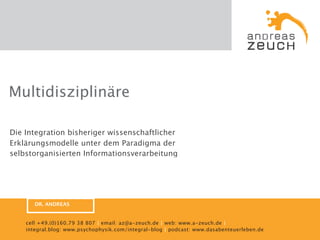
Multidisziplinäre Intuitionstheorie
- 1. Multidisziplinäre Die Integration bisheriger wissenschaftlicher Erklärungsmodelle unter dem Paradigma der selbstorganisierten Informationsverarbeitung DR. ANDREAS cell +49.(0)160.79 38 807 | email: az@a-zeuch.de | web: www.a-zeuch.de | integral.blog: www.psychophysik.com/integral-blog | podcast: www.dasabenteuerleben.de
- 2. Warum eine multidisziplinäre Intuitionstheorie? Ganz einfach: Bisher wird Intuition vorwiegend durch Erfahrungswissen erklärt. Daraus folgt immer wieder die Empfehlung, dass Experten auf Ihre Intuition achten sollen, Berufsanfän-ger aber nachdenken müssen. Dies ist wissenschaftlich belegbar Unfug. Auch Anfänger können erfolgreiche Intuition haben. © ANDREAS ZEUCH 2010
- 3. Bisherige Erklärungsmodelle (1) Klicken Sie auf die orange Schrift, wenn Sie mehr erfahren wollen. Zu jedem Erklärungsmodell gibts einen eigenen Artikel in meinem integral.blog. 1. Erfahrungswissen: Unsere Erfahrungen bilden den Informationspool, aus dem sich unsere Intuition bedient. 2. Unbewusste Wahrnehmung und Informationsverarbeitung: Wir nehmen nicht nur bewusst sondern vor allem auch unbewusst wahr. Zudem wird ein Großteil der wahrgenommen Daten unbewusst weiterverarbeitet. 3. Spiegelneurone: Unser Gehirn simuliert das Erleben unserer Mitmenschen, die wir beobachten. Das beste Erklärungsmodell für intuitive Empathie. © ANDREAS ZEUCH 2010
- 4. Bisherige Erklärungsmodelle (2) 4.Somatische Marker: Körperliche und mentale Signale, die in uns selbst wurzeln und unsere Aufmerksamkeit auf ein positives oder negatives Erleben hinlenken. 5.Fraktale Affektlogik: Unsere Gefühle sind die Grundlage unseres Denkens (genauer: unserer kognitiven Funktionen). Gefühle haben diesbezüglich sechs Funktionen. 6.Enterisches Nervensystem: Rund um unseren © ANDREAS ZEUCH 2010
- 5. Der gemeinsame Nenner aller Theorien Alle Theorien haben eine Gemeinsamkeit: Sie lassen sich als selbstorganisierte Informationsverarbeitung beschreiben. In allen Theorien besteht das wesentlich Element darin, dass kein bewusstes „Ich“ die Informationsverarbeitung steuert. Wenn man die Modelle grafisch zusammenfasst, entsteht das Bild auf der nächsten Folie. © ANDREAS ZEUCH 2010
- 6. Multidisziplinäre Intuitionstheorie: Intuition ist selbstorganisierte Aktuelle Emotionen, Affekte, Stimmungen Gerichtet auf bw/ubw Erfahrungswissen, Glaubenssätze, bw. Wille beinflusst Fördern oder hemmen bw / ubw. Relevanzsysteme Wahrnehmung Informationsverarbeitung Wissensmodi Intuition als menschliche unbewusst unbewusst SM Grundfunktion Implizites Wissen (IW) Externe & interne Somatische Bewusstseins- Kann zu IW Daten werden Marker fokus bewusst bewusst Explizites Wissen (EW) Kann über aktuelle Teilweise hemisphärenspezifische Speicherung / Erinnerung Denkprozesse zu Aufgabenbereiche EW führen IW: ZNS/ENS(?) EW: ZNS Fördern oder hemmen Gerichtet auf Aktuelle Denkprozesse © Andreas Zeuch Legende: EW=Explizites Wissen, IW=Implizites Wissen, ZNS=Zentrales Nervensystem, ENS=Enterisches Nervensystem, bw=bewusst, ubw=unbewusst © ANDREAS ZEUCH 2010
- 7. Vertiefende Literatur ‣ Zeuch, A. (2010): Feel it! Soviel Intuition verträgt Ihr Unternehmen. Wiley ‣ Zeuch, A. (2006): Am Rande des Chaos. Intuition als selbstorganisierende Intelligenz. Online beim Portal www.psychophysik.com ‣ Zeuch, A. (2004): Training professioneller intuitiver Selbstregulation. Theorie, Empirie und Praxis. Verlag Dr. Kovac. (die Dissertation aus der heraus das multidisziplinäre Modell © ANDREAS ZEUCH 2010
